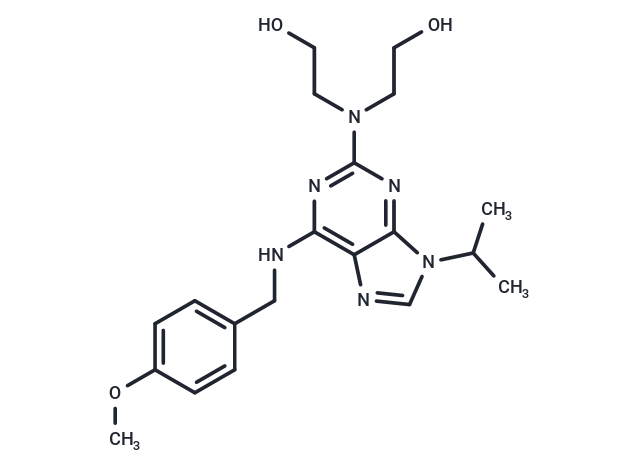Shopping Cart
- Remove All
 Your shopping cart is currently empty
Your shopping cart is currently empty

CVT-313 (NG-26) is a potent, selective, reversible, and ATP-competitive inhibitor.

| Pack Size | Price | Availability | Quantity |
|---|---|---|---|
| 1 mg | $37 | In Stock | |
| 2 mg | $50 | In Stock | |
| 5 mg | $80 | In Stock | |
| 10 mg | $121 | In Stock | |
| 25 mg | $219 | In Stock | |
| 50 mg | $400 | In Stock | |
| 100 mg | $595 | In Stock | |
| 1 mL x 10 mM (in DMSO) | $80 | In Stock |
| Description | CVT-313 (NG-26) is a potent, selective, reversible, and ATP-competitive inhibitor. |
| Targets&IC50 | CDK2:0.5 μM |
| In vitro | CVT-313 has been shown to inhibit other kinases, but at much higher IC50 values, i.e., CDK1 (IC50=4.2 μM), CDK4 D1 (IC50=215 μM), and MAPK/PKA/PKC (IC50>1.25 mM), compared to CDK2 (IC50=0.5 μM). CVT-313 has been shown to have profound effects on cell proliferation at concentrations of 5-20 μM[1]. CVT-313 is a potent CDK2 inhibitor, which is identified from a purine analog library with an IC50 of 0.5 μM in vitro. Inhibition is competitive with respect to ATP (Ki=95 nM), and selective CVT-313 has no effect on other, nonrelated ATP-dependent serine/threonine kinases. When added to CDK1 or CDK4, a 8.5- and 430-fold higher concentration of CVT-313 is required for half-maximal inhibition of the enzyme activity. Using normal and tumor human/murine cell lines, the effects of CVT-313 on cell proliferation is measured. The IC50 for growth inhibition ranged from 1.25 to 20 μM[2]. |
| Kinase Assay | For kinase assays, purified CDC5L(295-795)-His6 is mixed with [γ-32P]ATP, COS-7 cell extract, and incubated in 100 μL 20 mM HEPES, pH 7.5, 50 mM NaCl, 2 mM MnCl2, 10 mM MgCl2, 0.5% NP-40, 0.5 mM PMSF, 5 mM benzamidine hydrochloride, 5 mM NaF, 1 mM NaVO3 and the specific inhibitor at 30°C for 10 minutes. Cell extract as a source of kinase activity is prepared from subconfluent, serum-stimulated COS-7 cells lysed in 20 mM HEPES-NaOH, pH 7.5, 50 mM NaCl, 1% Triton X-100, 10% glycerol, protease and phosphotase inhibitors. Phosphorylated proteins are separated by electrophoresis in 15% polyacrylamide-SDS gels. Specific inhibitors included 20 μM staurosporine, 10 μM genistein, 1 μM CVT-313, 10 μM Rp-MB-cAMPS and 50 μM PD98059[1]. |
| Cell Research | CVT313 is prepared in DMSO and stored, and then diluted with appropriate medium before use[2]. MRC-5 cells are grown in Dulbecco's modified Eagle's medium containing 5% fetal calf serum. CVT313 (0, 5, 10, 15 μM) is added to exponentially growing cells in tissue culture. Cell population is measured. Proliferation assays are carried out using the nonradioactive CellTiter 96 kit after 48-h exposure. For FACS analysis of DNA content, cells are trypsinized, fixed in 70% ice-cold ethanol, and treated with 0.1 mg/mL RNase A and 40 μg/mL propidium iodide for 1 h at 37°C[2]. |
| Alias | NG26, CVT313, CVT 313, Cdk2 Inhibitor III |
| Molecular Weight | 400.47 |
| Formula | C20H28N6O3 |
| Cas No. | 199986-75-9 |
| Smiles | COc1ccc(CNc2nc(nc3n(cnc23)C(C)C)N(CCO)CCO)cc1 |
| Relative Density. | 1.3g/cm3 |
| Storage | Powder: -20°C for 3 years | In solvent: -80°C for 1 year | Shipping with blue ice. | |||||||||||||||||||||||||||||||||||
| Solubility Information | DMSO: 50 mg/mL (124.85 mM) | |||||||||||||||||||||||||||||||||||
Solution Preparation Table | ||||||||||||||||||||||||||||||||||||
DMSO
| ||||||||||||||||||||||||||||||||||||

Copyright © 2015-2024 TargetMol Chemicals Inc. All Rights Reserved.